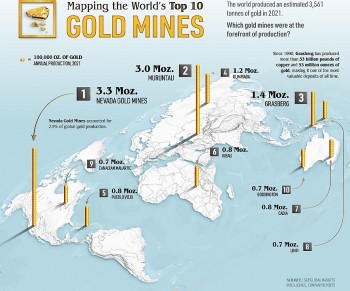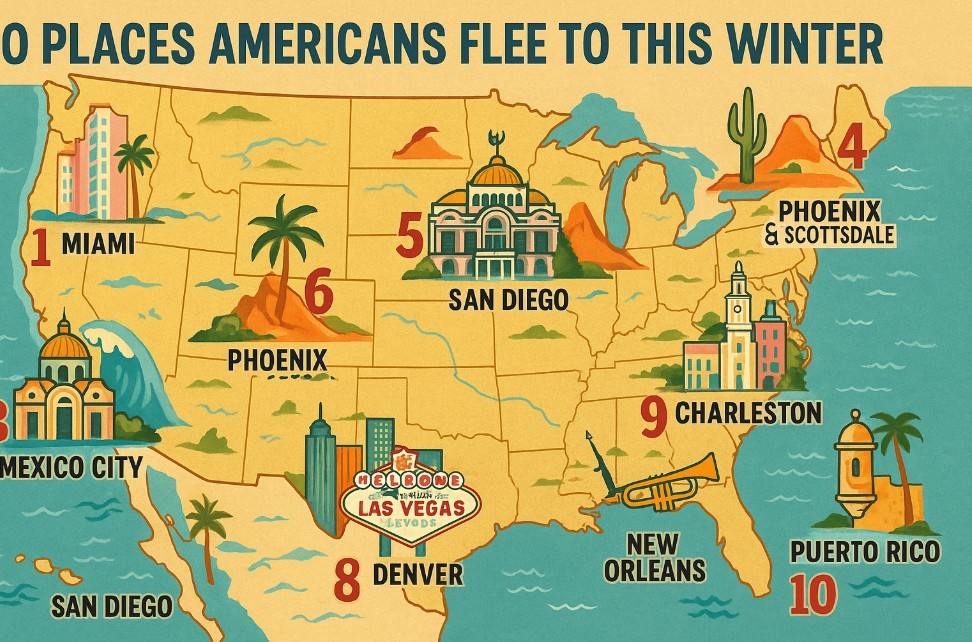Top 10 Countries with the Largest Gold Reserves in the World 2025
 Gold Fever: 10+ Biggest Gold Mines in the World Based on Production Gold Fever: 10+ Biggest Gold Mines in the World Based on Production There are currently over 1300 functioning gold mines worldwide. Where are the current most productive gold mines located with utmost precision? |
Gold remains one of the most trusted stores of value in a volatile global economy. Central banks around the world continue to rely on gold as a hedge against inflation, currency depreciation, and geopolitical risk. As of April 2025, the World Gold Council (WGC) and updated data from IMF and national central banks confirm the following list of countries with the largest official gold reserves.
Read more: Gold Fever: Vietnam Discovers 52 New Gold Mines in 2025, Redrawing Global Mining Map
 |
| The Gold Giants – 2025 |
1. United States – 8,133.5 tonnes
The U.S. remains the undisputed global leader in gold holdings. According to the U.S. Department of the Treasury, nearly all of its gold is stored in Fort Knox, Kentucky, the Denver Mint, and the West Point Bullion Depository. The gold stockpile has remained largely unchanged for decades, reflecting its central role in U.S. monetary stability.
Fun Fact: The U.S. gold reserve equals nearly 25% of all global official gold holdings.
Source: U.S. Treasury, WGC
2. Germany – 3,351.5 tonnes
Germany has successfully repatriated over 50% of its gold reserves from vaults in New York, London, and Paris. The gold is now mainly stored in Frankfurt. The Bundesbank emphasizes transparency and security, publishing detailed audits and even offering limited public tours of its gold vault.
Outlook: Germany is not expected to sell gold anytime soon; rather, it treats gold as a long-term strategic asset.
Source: Bundesbank.de
3. Italy – 2,451.8 tonnes
Despite economic challenges, Italy holds tight to its gold. The Bank of Italy considers gold a "guarantee of confidence and independence". Italy’s central bank, like Germany’s, emphasizes gold’s role in crisis mitigation rather than as a short-term investment tool.
Interesting Note: Italy's gold makes up over 65% of its total foreign reserves.
Source: IMF IFS Data
4. France – 2,437.0 tonnes
France's Banque de France is known for managing one of Europe’s largest gold vaults in Paris. The French central bank has increasingly modernized its gold management, and there have been internal discussions about using part of the reserves to back a sovereign wealth fund.
Strategic Insight: France is unlikely to increase its reserves significantly, but it remains committed to maintaining current levels.
Source: Banque de France
5. Russia – 2,332.7 tonnes
Russia has aggressively built its gold reserves since 2008 as part of its "de-dollarization" policy. Sanctions following the Ukraine conflict accelerated this trend. The Central Bank of Russia sees gold as a geopolitical shield and has even explored gold-backed cryptocurrency options.
Trend: Russia is shifting from USD to gold and Chinese yuan in its reserves portfolio.
Source: CBR.ru, WGC
6. China – 2,279.6 tonnes
China's actual gold reserves may exceed official figures. The People's Bank of China (PBoC) has been consistently increasing its holdings since late 2022. Analysts believe that China is stockpiling gold to strengthen the yuan as an international reserve currency.
Key Insight: China has added gold to its reserves for 16 consecutive months as of March 2025.
Source: People's Bank of China, Bloomberg
7. Switzerland – 1,039.9 tonnes
Switzerland, the home of global gold trading and private vaults, keeps a significant portion of its gold in Bern, the capital. The Swiss National Bank (SNB) maintains a conservative gold policy and focuses more on currency stability and foreign exchange interventions.
Historical Note: A 2014 referendum to force Switzerland to increase gold holdings to 20% was narrowly defeated.
Source: SNB.ch
8. India – 876.1 tonnes
India’s central bank has quietly increased gold purchases over the last five years. Gold also holds deep cultural significance in India, especially during wedding seasons and festivals. The Reserve Bank of India (RBI) has also started buying gold through the Bank for International Settlements (BIS).
Fun Fact: Including private holdings, India is estimated to have over 25,000 tonnes of gold, the most in the world.
Source: RBI.org.in, WGC India
9. Japan – 845.9 tonnes
Japan holds a steady but modest reserve compared to its GDP. The Bank of Japan is more focused on yen interventions than gold accumulation. However, gold plays a stabilizing role in its broader forex reserves mix.
Observation: Japan sold a small amount of gold in 2021 to fund COVID-19 stimulus, an unusual move for a developed nation.
Source: BoJ
10. Netherlands – 612.4 tonnes
The Dutch central bank has repatriated significant portions of its gold from the U.S. and Canada to Amsterdam. De Nederlandsche Bank views gold as the “ultimate trust anchor” in the event of a complete financial collapse.
Notable Plan: The Netherlands plans to build a new high-security gold vault near Zeist, expected to open by 2026.
Source: DNB.nl
Global Outlook and Trends
-
Central bank buying is strong: Over 1,100 tonnes were added globally in 2023, a record since 1967.
-
Emerging markets like Turkey, Kazakhstan, and Uzbekistan are rapidly growing their gold reserves.
-
Gold as digital backup: Talks of gold-backed digital currencies (especially in BRICS nations) are gaining traction.
-
Geopolitical uncertainty and de-dollarization are driving continued accumulation.
Conclusion
Gold is more than just a shiny metal—it's a cornerstone of economic defense. From Washington to Beijing, central banks are hoarding it with purpose. Whether as a bulwark against currency instability or as geopolitical leverage, gold's relevance in 2025 is stronger than ever.
If you're tracking the global economy or investing in gold, this list of top gold-reserve nations should be on your radar.
FAQs: Gold Reserves in 2025
1. Why do countries hold gold reserves?
Countries hold gold reserves as a hedge against inflation, currency volatility, and financial crises. Gold provides a universally accepted form of value that maintains purchasing power over time. It also adds diversification to central banks’ foreign reserve portfolios.
2. Which country has the most gold reserves in 2025?
As of April 2025, the United States holds the largest official gold reserves in the world with 8,133.5 tonnes, according to the World Gold Council.
3. Is China catching up to the U.S. in gold reserves?
While China is steadily increasing its gold holdings (currently at 2,279.6 tonnes), it still lags significantly behind the U.S. However, China's consistent monthly purchases suggest a long-term strategy to enhance yuan credibility on the global stage.
4. How often do central banks buy gold?
Central banks adjust their gold holdings based on economic, geopolitical, and currency-related factors. Some, like Russia and China, buy gold monthly. Others maintain steady reserves without frequent changes.
5. Do private citizens' gold holdings count in these figures?
No. The figures listed are official national reserves held by central banks. Private or household gold ownership—especially significant in countries like India and China—is not included in the WGC rankings.
6. Can countries sell their gold reserves?
Yes, countries can sell gold, but most major economies view gold as a strategic asset and avoid selling unless absolutely necessary (e.g., Japan's small sale during COVID-19 stimulus measures).
7. Are gold-backed digital currencies real?
They are being explored. Countries like Russia and members of the BRICS bloc have discussed developing gold-backed digital currencies as alternatives to U.S. dollar-based systems. However, none have yet launched at scale.
8. Where is most of the gold physically stored?
Gold is typically stored in high-security government vaults:
-
USA: Fort Knox, West Point, Denver Mint
-
Germany: Bundesbank vaults in Frankfurt
-
France: Paris (Banque de France)
-
UK/USA: Also host foreign countries’ gold in places like the Bank of England and the Federal Reserve Bank of New York.
9. How reliable are these gold reserve figures?
Figures are based on self-reported data to the IMF and World Gold Council, and are considered reliable. However, some analysts speculate countries like China and Russia may hold more than publicly disclosed.
10. Will gold remain important in the digital economy?
Absolutely. Despite the rise of digital assets and CBDCs (Central Bank Digital Currencies), gold remains a physical anchor of trust. Its scarcity, durability, and historical value continue to make it a core part of global financial systems.
 Global Gold Prices Surge Amid Economic Uncertainty and Trade Tensions Global Gold Prices Surge Amid Economic Uncertainty and Trade Tensions As of March 14, 2025, global gold prices have reached unprecedented levels, nearing the significant $3,000 per ounce mark. |
 Investors Brace for $4,000 Gold: What’s Fueling the Dramatic Price Surge? Investors Brace for $4,000 Gold: What’s Fueling the Dramatic Price Surge? Gold Prices Poised to Skyrocket: Expert Forecasts Predict Record Highs of $3,500 to $4,000 per Ounce. |
 Gold Price Holds Firm Above $3,130 as Trump’s Tariff Shock Sparks Market Jitters Gold Price Holds Firm Above $3,130 as Trump’s Tariff Shock Sparks Market Jitters Spot gold was up 0.6% at $3,129.46 an ounce at 04:53 p.m. EDT (2053 GMT). U.S. gold futures settled 0.6% higher at $3,166.20. |
 Gold Price Retreats from Record Highs: What’s Next for the Precious Metal? Gold Price Retreats from Record Highs: What’s Next for the Precious Metal? After soaring above $3,100 per ounce, gold prices have pulled back sharply. Is this a temporary dip or the start of a broader correction? |
























